This oven Roasted Tacos de Trompo Recipe will make you think you are at a five-star taqueria eating pork freshly shaved off a rotating trompo. This homemade tacos al pastor recipe recreates the trompo effect without the trompo, oven roasting stacked thinly sliced marinated pork in a covered Dutch oven. The recipe delivers succulent slices of moist, juicy, and crisp pork topped with and oh-so-sweet pineapple – for these are the best tacos ever. My mouth is watering. But you are probably wondering…!
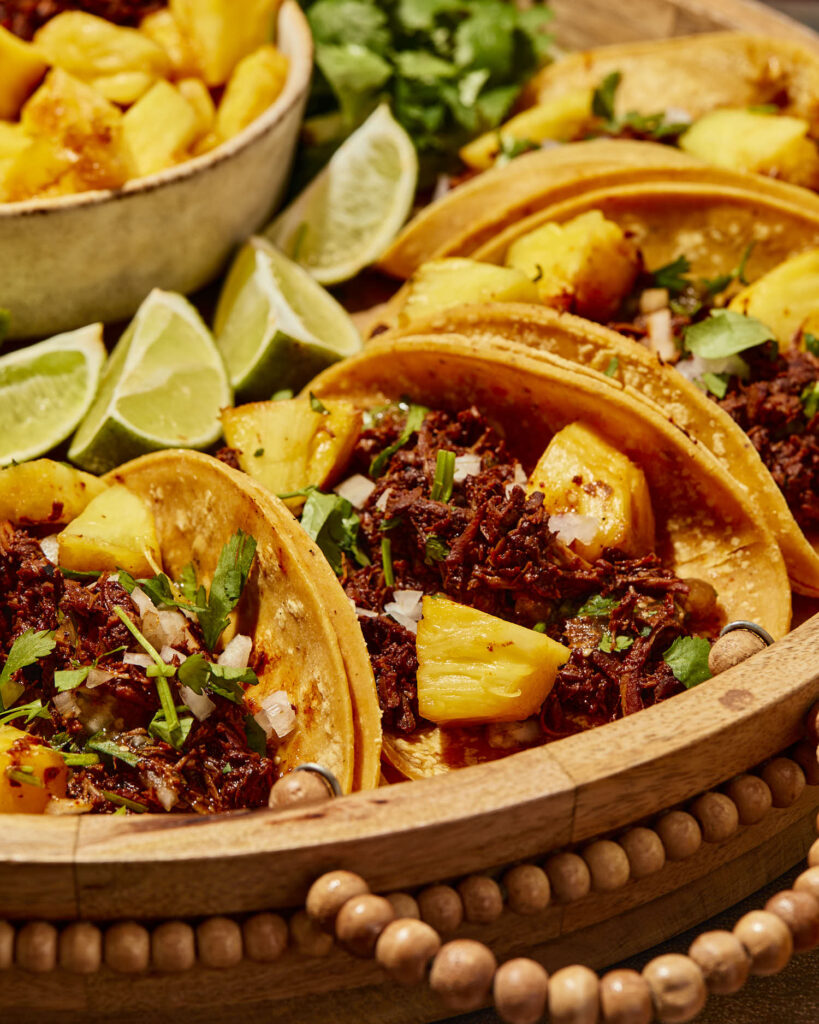
Table of Contents
- What is a Trompo?
- Tacos Árabes – a little History of the Tacos de Trompo Recipe
- Mexico City’s Tacos al Pastor
- Monterrey’s Tacos de Trompo
- Ingredients for Tacos de Trompo or Tacos al Pastor Recipe
- Chiles are Key for the Perfect Al Pastor Tacos de Trompo Recipe
- What is Mexican Oregano, and Why Does it Matter?
- Achiote Powder or Paste. Here’s What to Do
- Chipotle Chiles Packed in Adobo Sauce
- Boneless Pork Shoulder
- Salt your Tacos de Trompo recipe pork generously
- Heat
- How to Make a Tacos de Trompo Recipe
- The Juiciest Tacos de Trompo Recipe
What is a Trompo?
Great question. Trompo is a very popular dish(spinning top) sometimes refers to the actual cooking device: the vertical rotating spit of meat. Or it can refer to dishes featuring meat cooked on a trompo. But don’t worry, if you don’t have a rotating spit – I have a great solution to get the same great cooking flavors in a traditional dutch oven.
Tacos Árabes – a little History of the Tacos de Trompo Recipe
The origins of tacos de trompo begins in the early 1900s, when waves of Lebanese immigrants settled in Puebla, Mexico. These immigrants brought their culinary traditions, ingredients, and utensils with them, including the vertical spit used to make shawarma. This is not gyro meat from street vendors.
Mexicans adapted the cooking method to their own local ingredients and flavors and the result was called tacos árabes (Arab tacos). Living in California, we are so spoiled with amazing types of tacos via corner taquerias. Layers of meat with al pastor pork, a slice of pineapple from a flavorful marinade, and chipotle peppers is (IMO) the best type of taco. I was thrilled when I could recreate my favorite dish at home and share it with y’all – especially my friends outside of the state. I know it’s hard to find good tacos elsewhere – but I gotcha covered.
Mexico City’s Tacos al Pastor
Eventually Mexico City caught on to the trend. Because the Lebanese were pastoral workers, Mexico City residents chose to call their version tacos al pastor (shepherd-style tacos).
The distinctive local flavors of achiote and citrus made their appearance in this variation and soon spread.
Monterrey’s Tacos de Trompo
In Monterrey, the capital of the Nuevo León state, the pork became more heavily seasoned with adobos containing lots of paprika, resulting in an orange color and a smoky spicier flavor. I’m gonna teach you how to make this! It’s so good guys.
Monterrey called their version Tacos de Trompo, which are typically served with raw white onion, cilantro, and salsa.
In the end, no matter what you call these tacos, the tastiness remains the same across the board. Here’s what to grab at the grocery store or your pantry. the history lesson is done. Ready to dive in? Let’s do it.
Ingredients for Tacos de Trompo or Tacos al Pastor Recipe
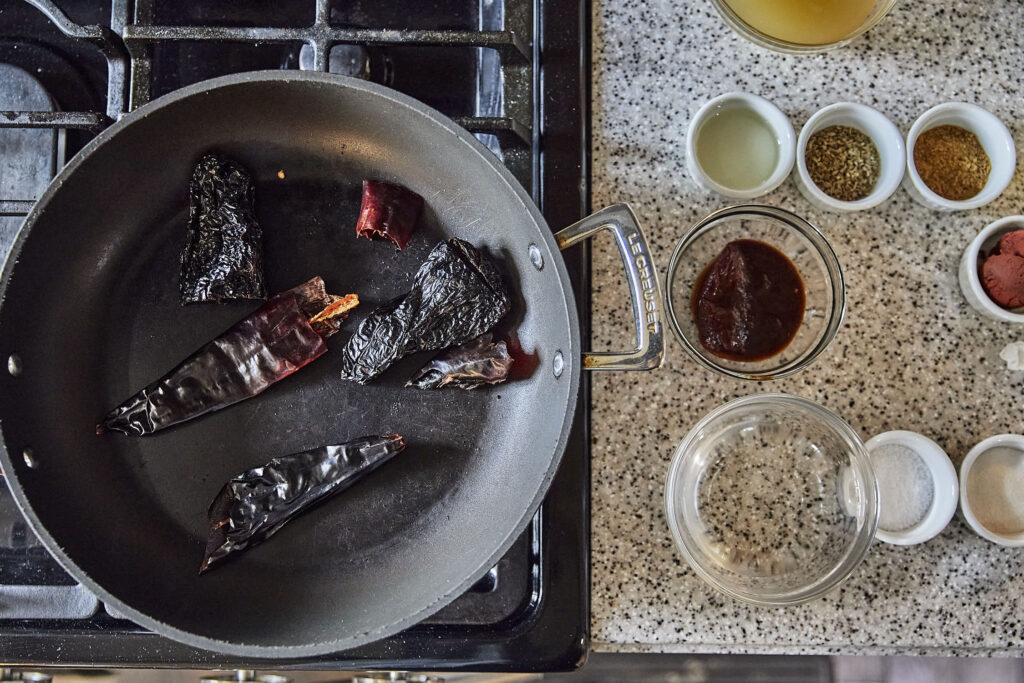
The full list of ingredients to make these delicious tacos de trompo at home is as follows:
- 2 ancho chiles, seeds and stems removed
- 2 pasilla or guajillo chiles, seeds and stems removed
- ¾ cup low-sodium chicken broth
- 2½ teaspoons vegetable oil
- 1½ teaspoons dried Mexican oregano*
- 1½ teaspoons dried ground cumin
- 1½ tablespoons achiote powder or paste*
- 1 chipotle chile packed in adobo sauce + 1 tablespoon sauce from can
- ⅓ cup distilled white vinegar
- 3 ⅜ teaspoons Morton kosher salt*
- 2½ teaspoons sugar
- 4 garlic cloves
- 3 pounds boneless pork shoulder*
- 1 pineapple, peeled*
- 6 to 8 corn tortillas or flour tortillas, warmed in microwave, oven, or skillet
- 1 white onion, diced
- ½ cup cilantro, minced
- Salsa verde or salsa of your choice
- 4 limes, cut into wedges
Most of the ingredients in this are often used in the kitchen. However, there are a couple that may leave you scratching your head.
They also happen to be the most important ingredients, giving tacos de trompo its distinctive color and flavor.
Chiles are Key for the Perfect Al Pastor Tacos de Trompo Recipe
To make these homemade tacos de trompo, you’ll need to buy some dried whole chiles. These can be found in the international section of your grocery story or in the spice section.
The chiles should still be flexible. Ones that are dry, brittle, and crackly are too old and a lot of the flavors will have dissipated.
There are a lot of chiles to choose from. For this recipe, use
- Two Ancho chiles, which adds rich flavor to sauces (mole, enchilada, etc.)
- Two Guajillo or two pasilla chiles, which will add some bright notes to the marinade
Make sure to remove the seeds and stems of the chiles before use.
What is Mexican Oregano, and Why Does it Matter?
Mexican oregano has a different flavor profile than oregano.
The two plants are actually completely unrelated, with Mexican oregano being a member of the verbena family and “plain” oregano being a part of the mint family.
Plain oregano is slightly sweet, bitter, and peppery. Mexican oregano is more floral and citrusy, with slight hints of anise.
So really, the two are completely different and I wouldn’t recommend substituting one for the other. A better substitute if you don’t have Mexican oregano available is marjoram. It is a little bit more citrusy then plain oregano.
Achiote Powder or Paste. Here’s What to Do
Achiote is a spice that comes from the seeds of an evergreen shrub (Bixa orellana) that is native to the tropics of the Americas.
It is often also called annatto but goes by many names depending on where in the world you are.
- Achiote (Mexico, Nahuatl language groups, Spanish-speaking countries in the Caribbean)
- Annato (Caribbean islands, areas of South America)
- Roucou (Trinidad, Tobago, Martinique, Guadalupe)
- Achuete (Philippines)
In small amounts, it’s used as a coloring agent, adding yellow color to chorizo, butter, and cheese.
When used in larger amounts, it adds an earthy and black pepper flavor to foods. It has a hint of bitterness and the seeds have slight floral and peppermint scents.
When achiote powder is mixed with other spices, herbs, and vinegar, a paste forms. This recipe already contains all the ingredients to make achitote paste from powder.
However, you can use paste as well without the flavor being too overpowering.
Chipotle Chiles Packed in Adobo Sauce
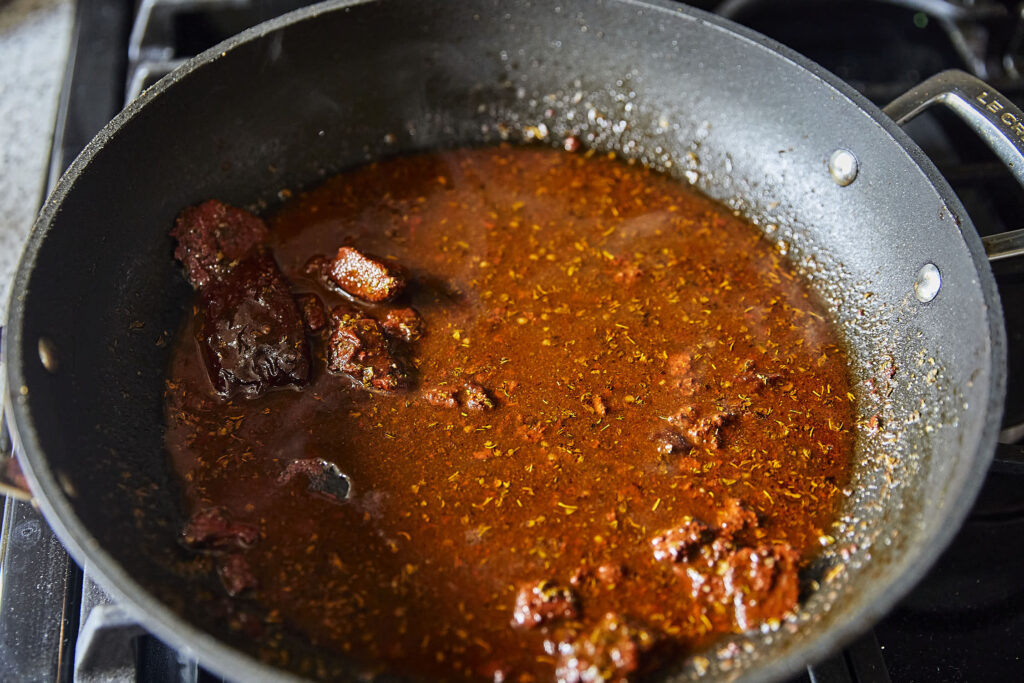
Chipotles in adobo are jalapeños that have been dried, rehydrated, and canned in a purée of tomato, vinegar, garlic, and spices. They are smoky, tangy, and pack a lot of heat.
Cans of chipotle chiles in adobo sauce can be found in the international aisle of most supermarkets along with other Mexican ingredients. But they are also sometimes stocked with canned tomato products or in the general condiment aisle.
Boneless Pork Shoulder
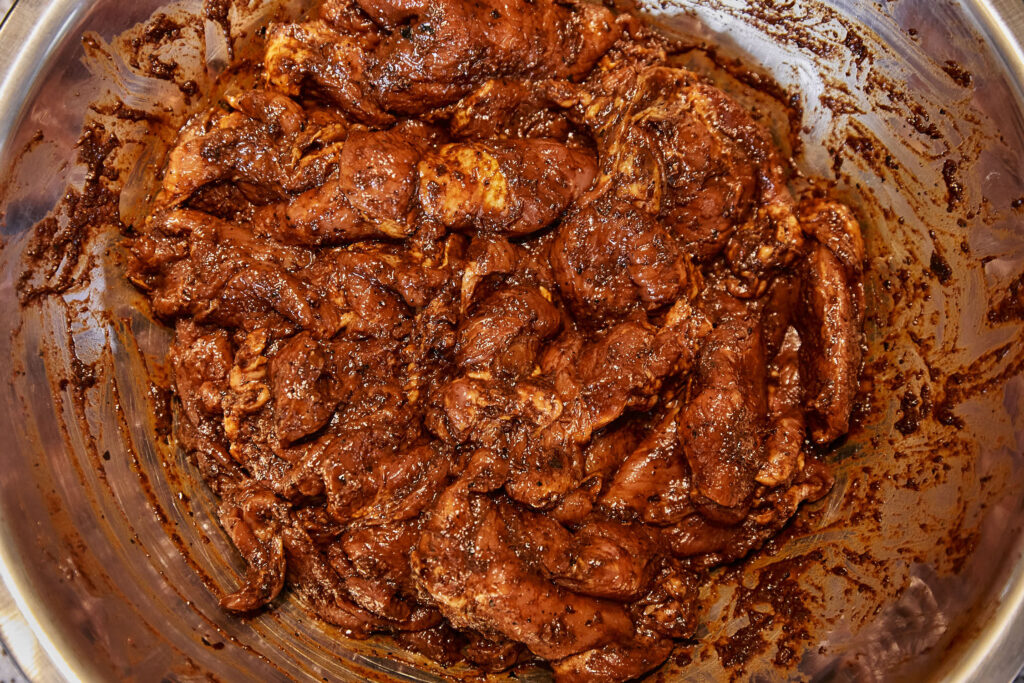
Pork shoulder is an inexpensive cut of meat that is marbled with the outer layer of meat fat and connective tissue. This makes it a tough cut of meat. But when cooked low and slow, pork shoulder transforms into a fall-apart tender treat.
Two cuts of meat come from the shoulder:
- Pork shoulder, also known as a picnic roast, is from the lower region of the arm
- Pork butt roast, also known as Boston shoulder or Boston butt, is from the upper section of the shoulder
For this recipe, look for a cut from the lower region of the arm, pork shoulder (picnic roast). You will eventually cut and serve this Mexican food dish into small pieces
Pork shoulder is more appropriate for recipes where the meat is meant to be sliced while pork butt is better for when meat is meant to be shredded. However, the two can be used interchangeably if you can’t find a pork shoulder cut.
There are two very important ingredients to ensure the pork cooks well to mimic the spit-grilled meat shoulder technique for tacos de trompo: salt and heat.
Salt your Tacos de Trompo recipe pork generously
Properly salting the boneless pork shoulder is key in helping to get the best tacos de trompo recipe meat with coherent slices that are moist, juicy, and crisp.
How much salt you use should be based on how many pounds of your pork shoulder is. The amount of salt used per pound of boneless meat should be about 1.25% by weight.
Using Morton Kosher Salt means 3 pounds of boneless pork shoulder should be salted with 3 and ⅜ teaspoons (1 and ⅛ teaspoons salt per pound).
Heat
Boneless pork shoulder should be cooked low and slow, and should hold an internal temperature of 200 degrees for at least an hour. This is how all the tough fat and connective tissue melts into juicy tender goodness.
However, the dry heat of the oven can cause the pork to heat too slowly, causing the surface of the meat to be leathery.
So to retain moisture and prevent the meat from becoming tough and leathery, cooking the pork shoulder covered is the easiest solution.
Using a Dutch oven was the best option for this homemade tacos de trompo recipe. It’s deep enough for thinly sliced pork slices to be stacked on a skewer and cooked vertically with the lid on.
At 275 degrees Fahrenheit, boneless pork shoulder will cook at 90 minutes per pound (4.5 hours for a 3 pound cut). Adjust the cooking time depending on how much your pork shoulder weighs.
Pork should reach 180-185 degrees Fahrenheit in the center before taking it out of the oven. Carryover cooking will take the temperature up to 190 degrees Fahrenheit for safe serving.
How to Make a Tacos de Trompo Recipe
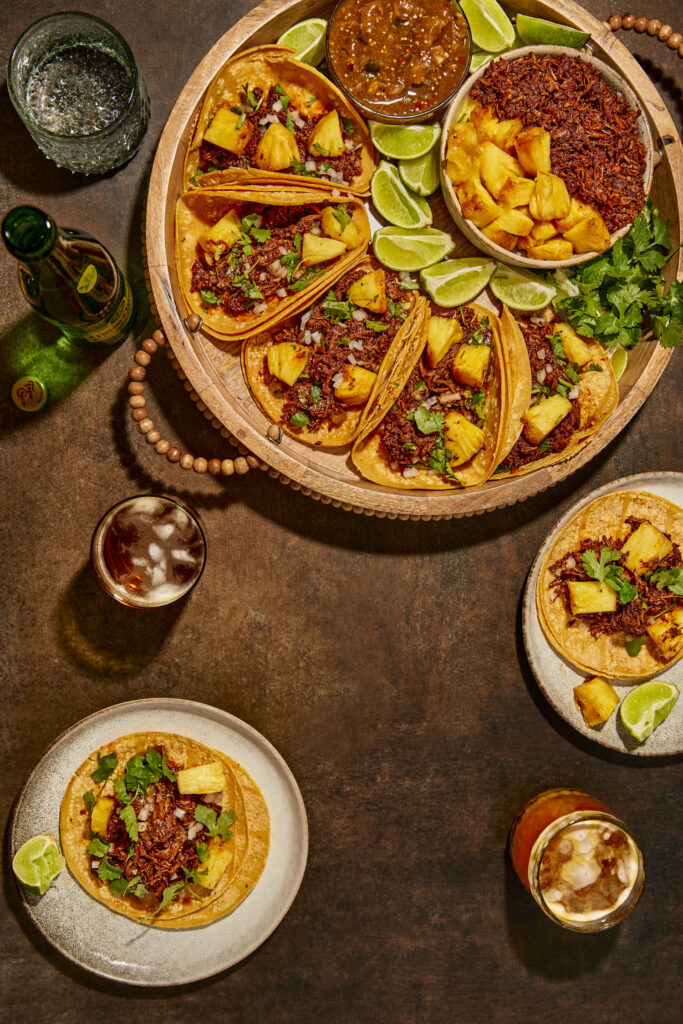
Put the pork shoulder in the freezer for 15 minutes. This makes it easier to cut into thin slices. While the pork is firming up, prepare the marinade.
Cook the chiles in a large skillet over medium high heat for 5 minutes. They should be puffing up, pliable, browning in spots, and very aromatic.
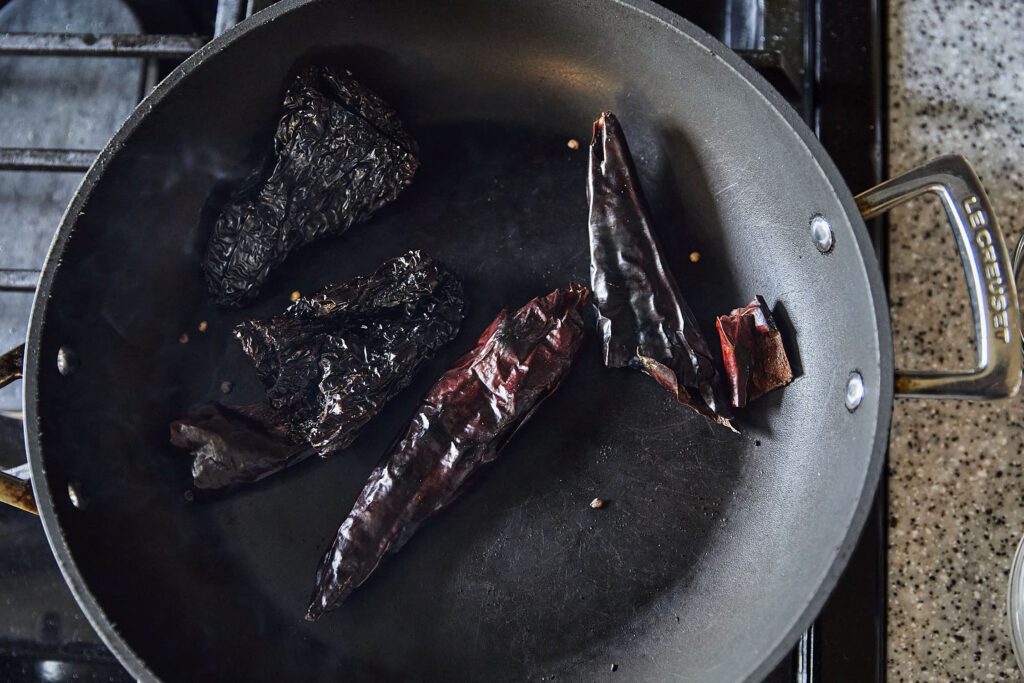
Add the chicken stock to the skillet and then pour the chiles and stock into a medium bowl. Place a plate, towl, or plastic wrap over the top and set aside.
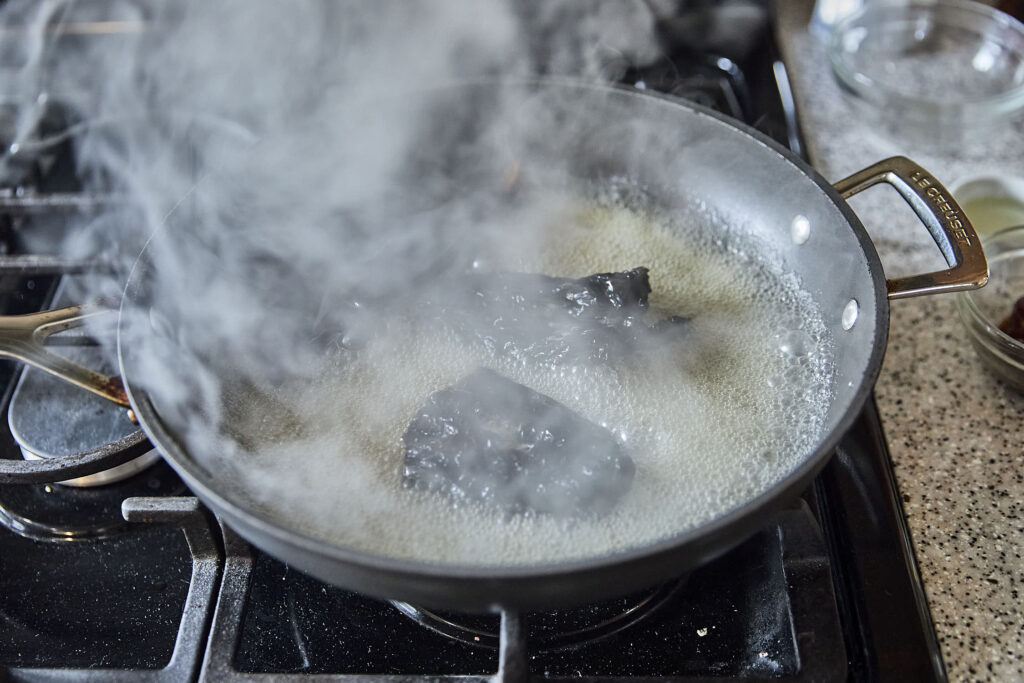
Dry the saucepan and add the vegetable oil. Heat on medium high until the oil is shimmering. Add the oregano, cumin, and achiote, stirring frequently for about 30 seconds. The spices should smell aromatic but not browned.
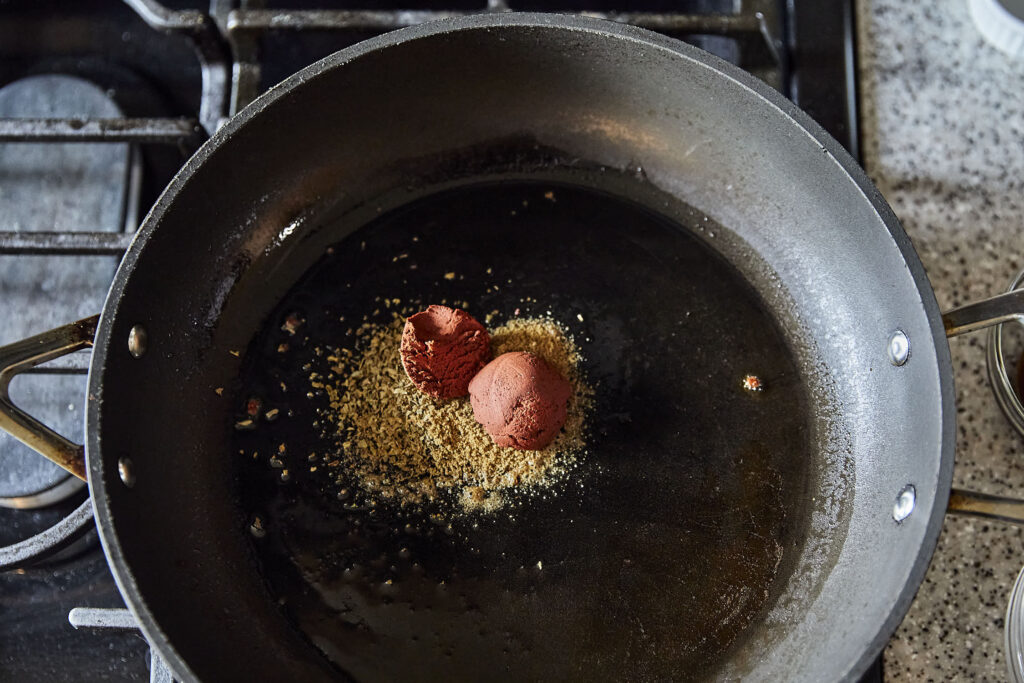
Add the chipotle chile and adobo sauce and cook for 30 more seconds.
Stir in the vinegar, salt, and sugar and remove from heat.
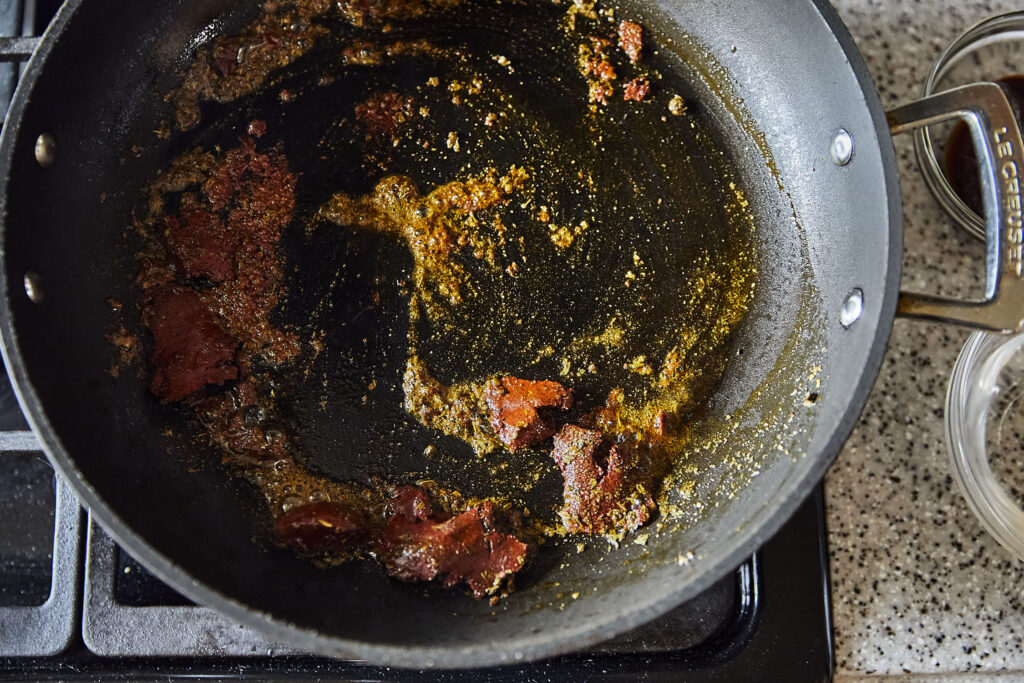
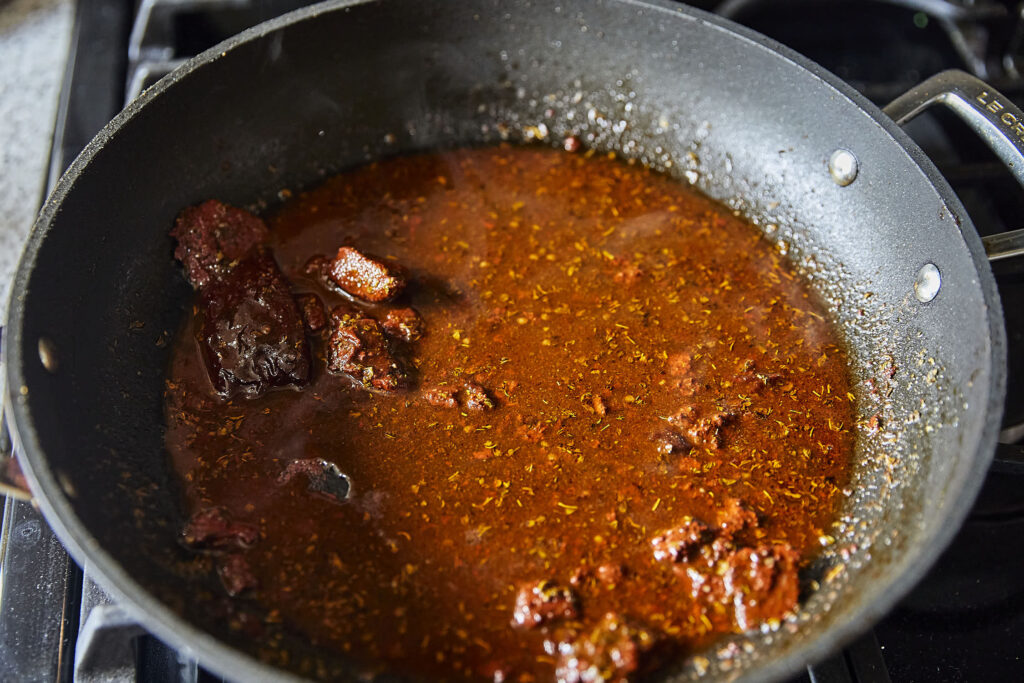
Scrape the contents of the skillet into a food processor or blender. Toss in the garlic cloves and pour the chiles and their soaking liquid and blend on high speed until completely smooth. Set aside.
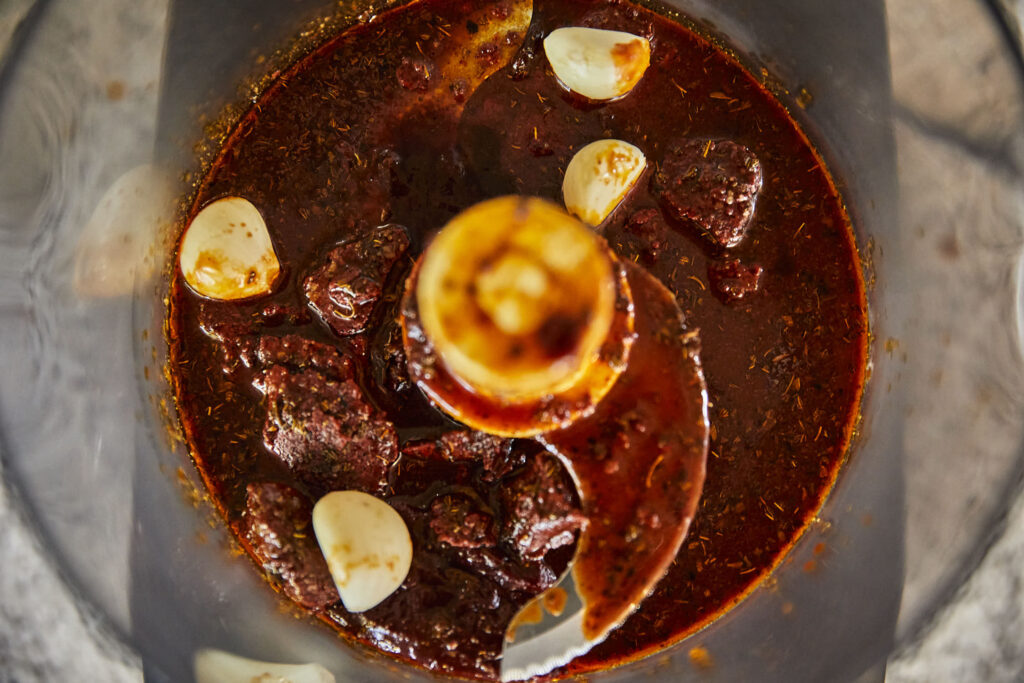
Take the pork out of the freezer and slice it as thinly as possible.
Place one slice of pork into a heavy duty ziplock bag and pound with a meat pounder or the bottom of a heavy skillet until it is less than ¼ of an inch thick. Place in a large bowl and repeat with the rest of the pork slices.
Add the marinade to the bowl and toss with your hands (wear disposable rubber gloves to protect your hands from the heat of the chilies). Make sure every slice of pork is evenly coated.
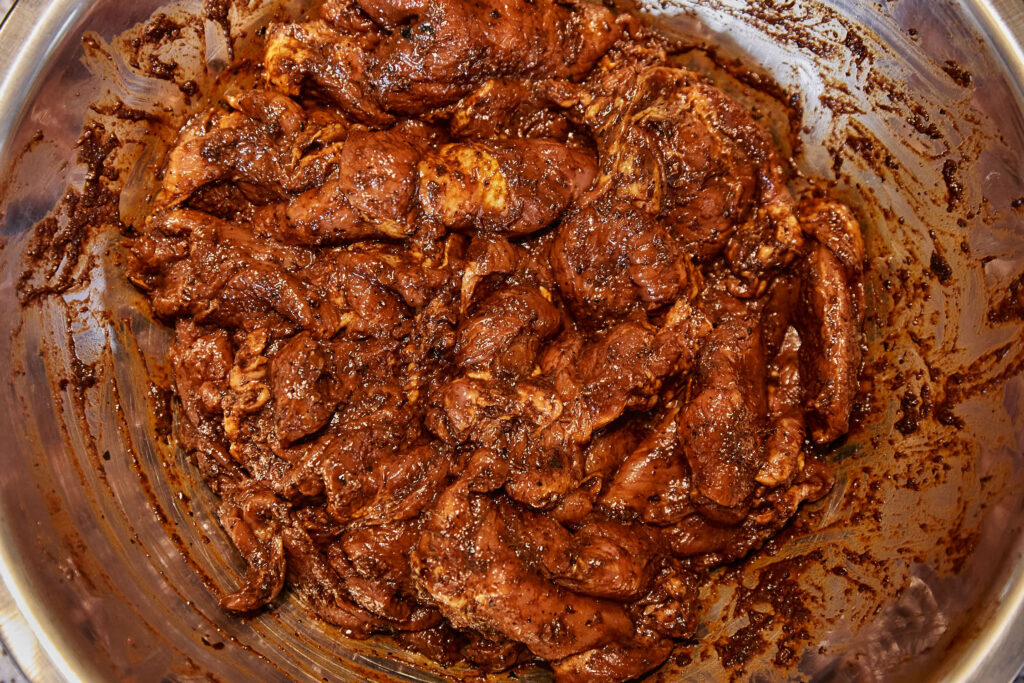
Wrap tightly in plastic wrap or transfer to a ziplock bag and marinate for at least 4 hours or up to 36.
When the meat is finished marinating, preheat the oven to 275 degrees Fahrenheit.
Cut two circular rounds off the top and bottom of the peeled pineapple and set aside. Core the rest of the pineapple and cut into quarters lengthwise.
Take a skewer and make sure that it can stand up straight in a large dutch oven with the lid on. Cut it down to size if it is too tall.
Place one of the pineapple round slices on the skewer to form a base. Begin adding layers of the pork on top of the pineapple. At the very top of the pork slices, add the second pineapple slice.
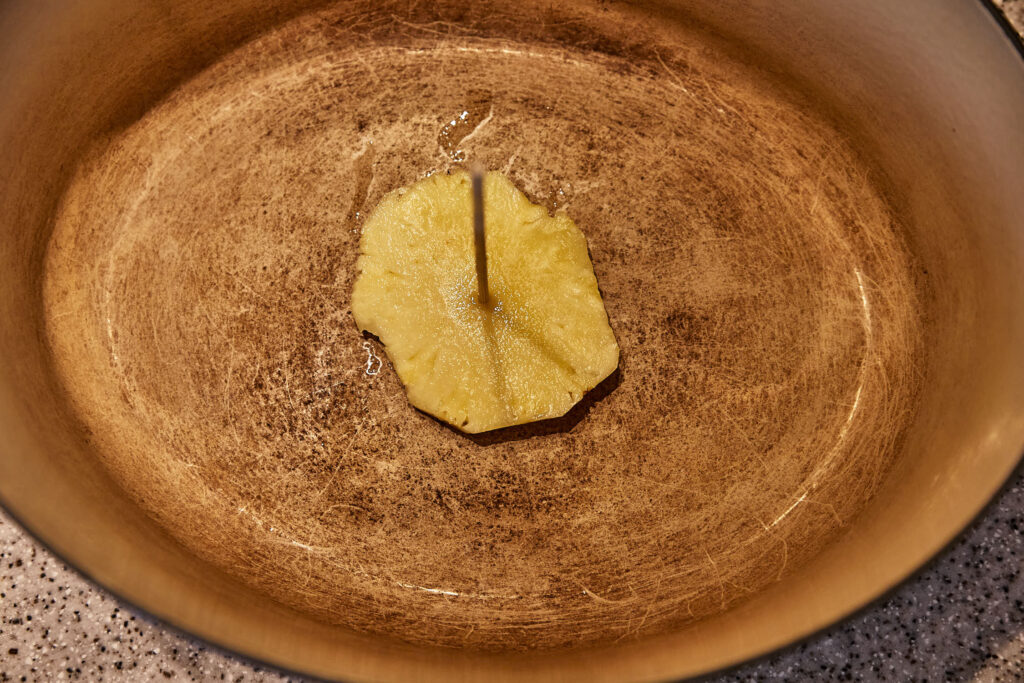
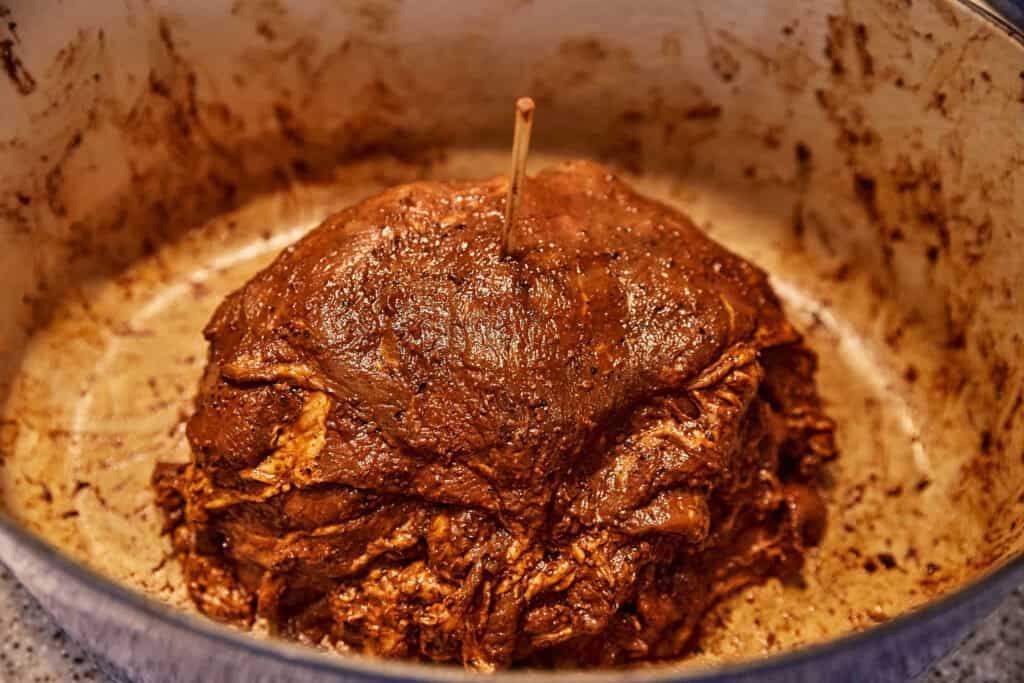
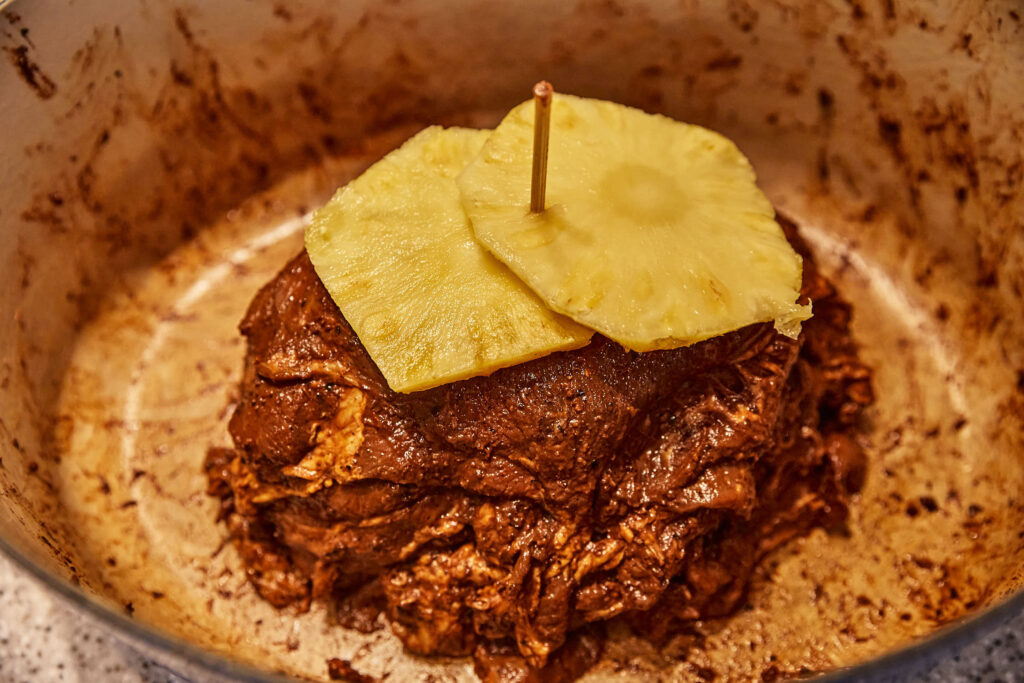
Cover with the lid and cook in the oven for 4 hours.
Remove from the oven and take the lid off. Put the pineapple quarters in the dutch oven, making sure to flip them so that all the sides are covered in fat.
Put back in the oven and cook uncovered for 25 minutes, until the pineapple is tender.
Carefully remove the skewered pork from the dutch oven and place on a cutting board. Let the meat rest for 10 minutes (or until the internal temperature reaches 120 degrees).
While the meat rests, prep the condiments.
Cut the pineapple into large chunks. Dice and mince the onion and cilantro. Cut the limes into wedges, and put the salsa in a serving bowl. For a perfect Tacos de Trompo Recipe ya’ gotta have lots of fresh pineapple and cilantro.
Warm the tortillas in the microwave, oven, or skillet, whichever method you prefer. There are different methods. I like to flip them directly on the gas grill! You can do it.
Pour all the fat and juices that collected in the dutch oven into a measuring glass or bowl and set aside.
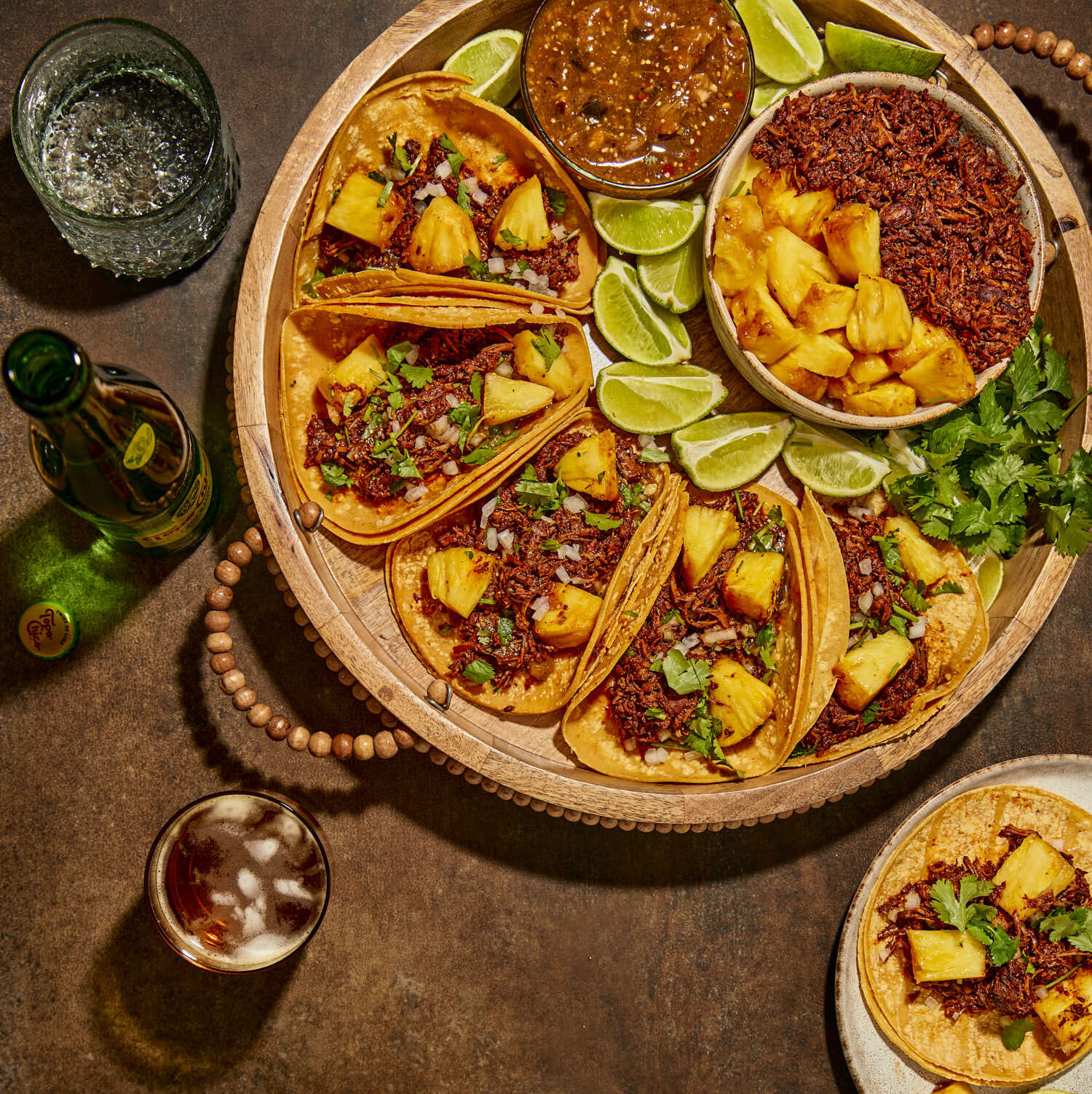
Using a chef’s sharp knife or slicing knife, thinly slice the meat, creating fine shavings of meat.
Heat 1 tablespoon of reserved juices in a large skillet over medium heat. Add the meat and cook, stirring occasionally, until the meat crisps and deeply browns in spots.
Add the rest of the reserved drippings and toss to combine. Cook until the juices are reduced to a moist glaze. Transfer to a serving bowl.
Serve the meat and pineapple slices with warm tortillas, onions, cilantro, salsa, and a squeeze of lime juice with wedges.
Loves, you have to try this recipe. It’s literally the best taco you will ever have. Trust me on this one.
Not in the mood for tacos? Try this amazing and easy homemade hamburger helper, or zesty honey bacon pasta. They are my go-to for quick lunches.

The Juiciest Tacos de Trompo Recipe
Ingredients
- 2 count ancho chiles, seeds and stems removed
- 2 count pasilla or guajillo chiles, seeds and stems removed
- 3/4 cup low-sodium chicken broth
- 2 1/2 tsp vegetable oil
- 1 1/2 tsp dried Mexican oregano*
- 1 1/2 tsp dried ground cumin
- 1 count chipotle chile packed in adobo sauce + 1 tablespoon sauce from can
- 1/3 cup distilled white vinegar
- 3 3/8 cup teaspoons Morton kosher salt*
- 2 1/2 tsp sugar
- 4 count garlic cloves
- 3 pounds boneless pork shoulder*
- 1 count pineapple, peeled or pineapple chunks
- 6-8 count corn or flour tortillas, warmed in microwave, oven, or skillet
- 1 count white onion, diced
- 1/2 cup cilantro, minced
- 1 can Salsa verde or salsa of your choice
- 4 count 4 limes, cut into wedges
Instructions
- Put the pork shoulder in the freezer for 15 minutes. This makes it easier to cut into thin slices. While the pork is firming up, prepare the marinade.
- Cook the chiles in a large skillet over medium high heat for 5 minutes. They should be puffing up, pliable, browning in spots, and very aromatic.
- Add the chicken stock to the skillet and then pour the chiles and stock into a bowl. Place a plate, towl, or plastic wrap over the top and set aside.
- Dry the saucepan and add the vegetable oil. Heat on medium high until the oil is shimmering. Add the oregano, cumin, and achiote, stirring frequently for about 30 seconds. The spices should smell aromatic but not browned.
- Add the chipotle chile and adobo sauce and cook for 30 more seconds.
- Stir in the vinegar, salt, and sugar and remove from heat.
- Scrape the contents of the skillet into a food processor or blender. Toss in the garlic cloves and pour the chiles and their soaking liquid and blend on high speed until completely smooth. Set aside.
- Take the pork out of the freezer and slice it as thinly as possible.
- Place one slice of pork into a heavy duty ziplock bag and pound with a meat pounder or the bottom of a heavy skillet until it is less than ¼ of an inch thick. Place in a large bowl and repeat with the rest of the pork slices.
- Add the marinade to the bowl and toss with your hands (wear disposable rubber gloves to protect your hands from the heat of the chilies). Make sure every slice of pork is evenly coated.
- Wrap tightly in plastic wrap or transfer to a ziplock bag and marinate for at least 4 hours or up to 36.
- When the meat is finished marinating, preheat the oven to 275 degrees Fahrenheit.
- Cut two circular rounds off the top and bottom of the peeled pineapple and set aside. Core the rest of the pineapple and cut into quarters lengthwise.
- Take a skewer and make sure that it can stand up straight in a large dutch oven with the lid on. Cut it down to size if it is too tall.
- Place one of the pineapple round slices on the skewer to form a base. Begin adding layers of the pork on top of the pineapple. At the very top of the pork slices, add the second pineapple slice.
- Cover with the lid and cook in the oven for 4 hours.
- Remove from the oven and take the lid off. Place pineapple quarters in the dutch oven and flip them so that all the sides are covered in fat.
- Put back in the oven and cook uncovered for 25 minutes, until the pineapple is tender.
- Carefully remove the skewered pork from the dutch oven and place on a cutting board. Let the meat rest for 10 minutes (or until the internal temperature reaches 120 degrees).
- Cut the pineapple into large chunks. Dice and mince the onion and cilantro. Cut the limes into wedges, and put the salsa in a serving bowl.
- Warm the tortillas in the microwave, oven, or skillet, whichever method you prefer.
- Pour all the fat and juices that collected in the dutch oven into a measuring glass or bowl and set aside.
- Using a chef’s knife or slicing knife, thinly slice the meat, creating fine shavings of meat.
- Heat 1 tablespoon of reserved juices in a large skillet over medium high heat. Add the meat and cook, stirring occasionally, until the meat crisps and deeply browns in spots.
- Add the rest of the reserved drippings and toss to combine. Cook until the juices are reduced to a moist glaze. Transfer to a serving bowl.
- Serve the meat and pineapple with warm tortillas, onions, fresh cilantro, salsa, and lime wedges.
Notes
-
- Mexican oregano has an excellent flavor profile that differs from oregano’s. The two plants are entirely unrelated. Mexican oregano is a member of the verbena family, while plain oregano is a member of the mint family. Plain oregano is slightly sweet, bitter, and peppery. Mexican oregano is more floral and citrusy, with slight hints of anise. So, the two are entirely different, and I wouldn’t recommend substituting one.
-
- A better substitute if you don’t have Mexican oregano available is marjoram. It is a little more citrusy than plain oregano.
-
- Use Achiote powder and paste interchangeably. Achiote powder is sometimes referred to as annatto powder.
-
- The amount of salt you use should vary depending on the weight of your boneless pork shoulder. Use the ratio 1⅛ teaspoons per pound.
-
- Properly salting the boneless pork shoulder is key to achieving excellent trompo meat with coherent slices that are moist, juicy, and crisp. Take into account the weight of your boneless pork shoulder. The amount of salt per pound of boneless meat is 1.25% by weight. If you are using Morton Kosher Salt, that means 3 pounds of boneless pork shoulder should be salted with 3 and ⅜ teaspoons (1 and ⅛ teaspoons salt per pound).
-
- At 275 degrees Fahrenheit, boneless pork shoulder will cook at 90 minutes per pound (4.5 hours). Adjust the cooking time depending on how much your pork shoulder weighs.
-
- Before taking the pork out of the oven, its center temperature should be 180-185 degrees Fahrenheit. For safe serving, carryover cooking will raise the temperature to 190 degrees Fahrenheit.
-
- When squeezed, look for pineapples with green leaves and a firm shell with a small amount of give. The pineapple shouldn’t be rock-hard.
-
- The more yellow the exterior is, the riper the fruit will be.
-
- If the color is going towards dark orange, it’s gone too far.
-
- It should feel heavy, not hollow.
-
- Put your nose close to the bottom of the fruit. If you can smell that fresh pineapple smell, then it’s ready to buy and eat. If it smells funky and fermented (like vinegar), it’s gone too far.
Nutrition
Nutrition information is automatically calculated, so should only be used as an approximation.














Salting the boneless pork shoulder is key to achieving excellent trompo meat with crisp, juicy slices. Be sure to consider the weight of your boneless pork shoulder and salt accordingly, my friends. See you in the Kitchen!